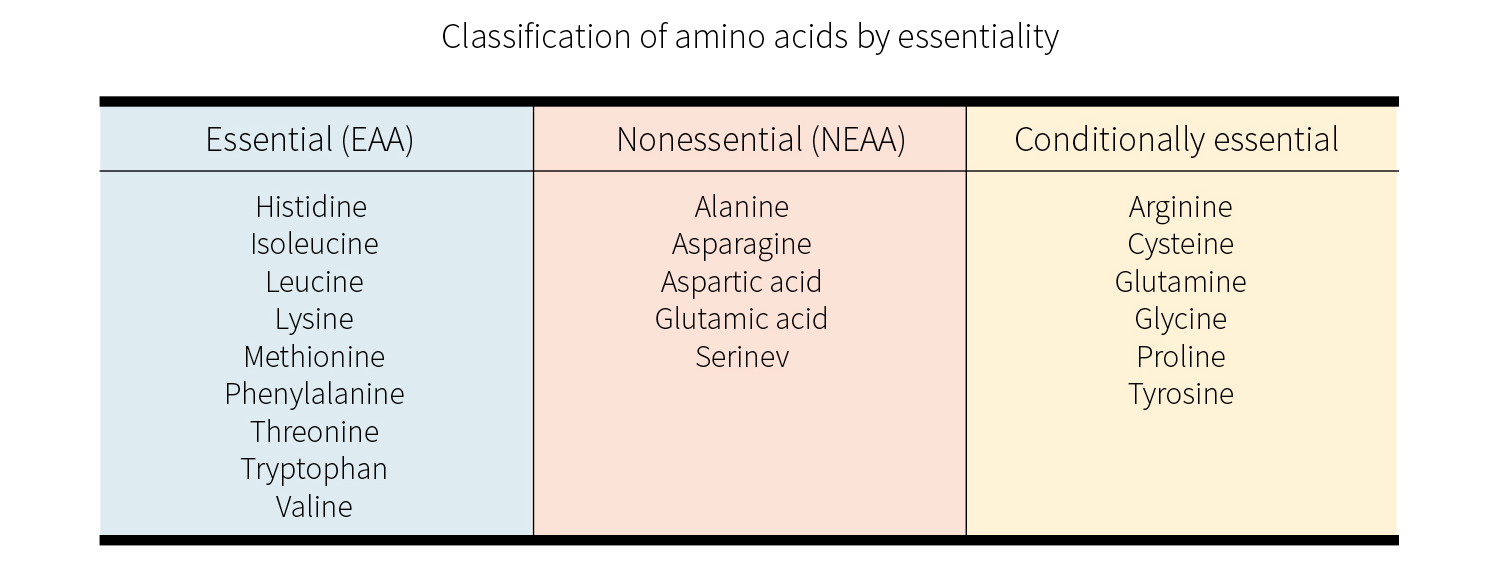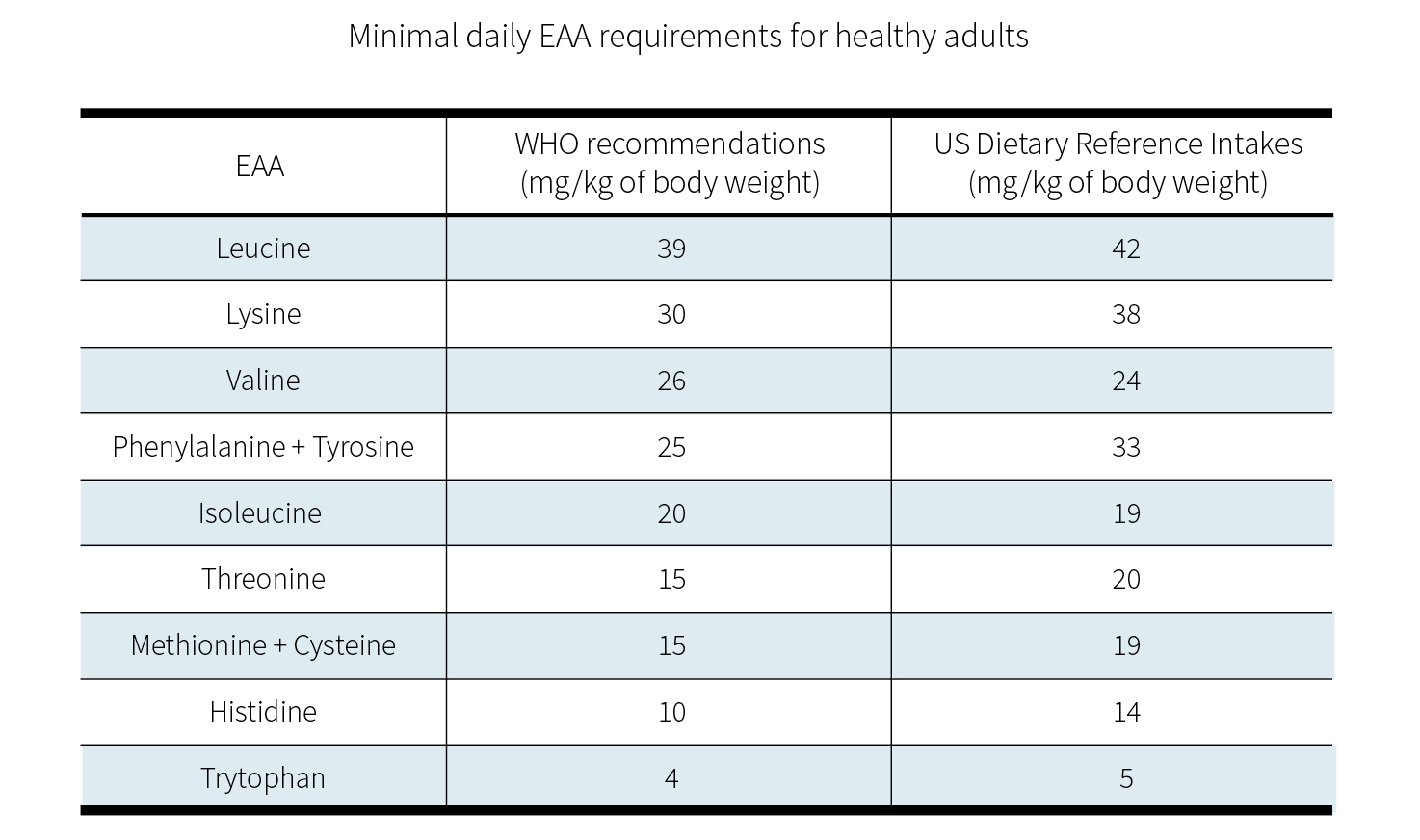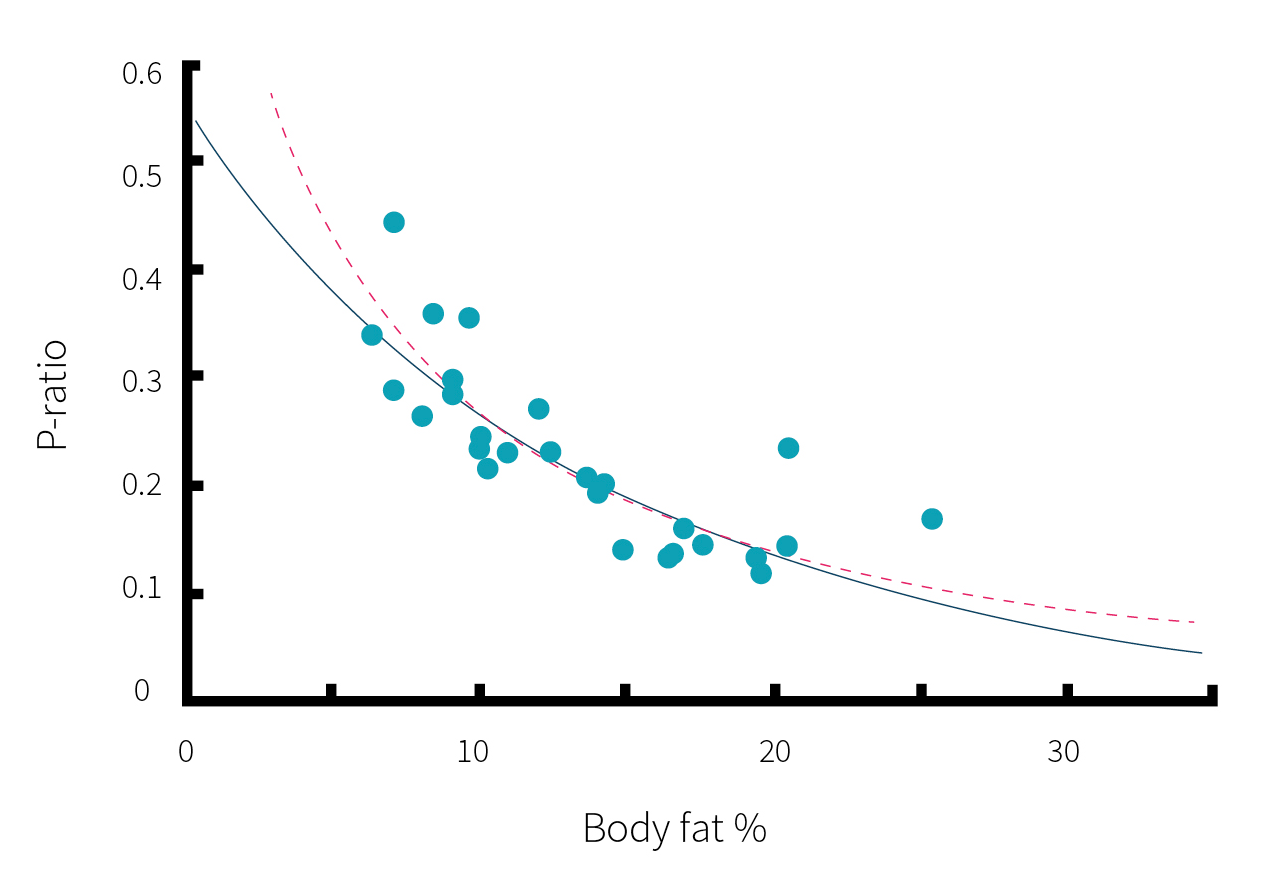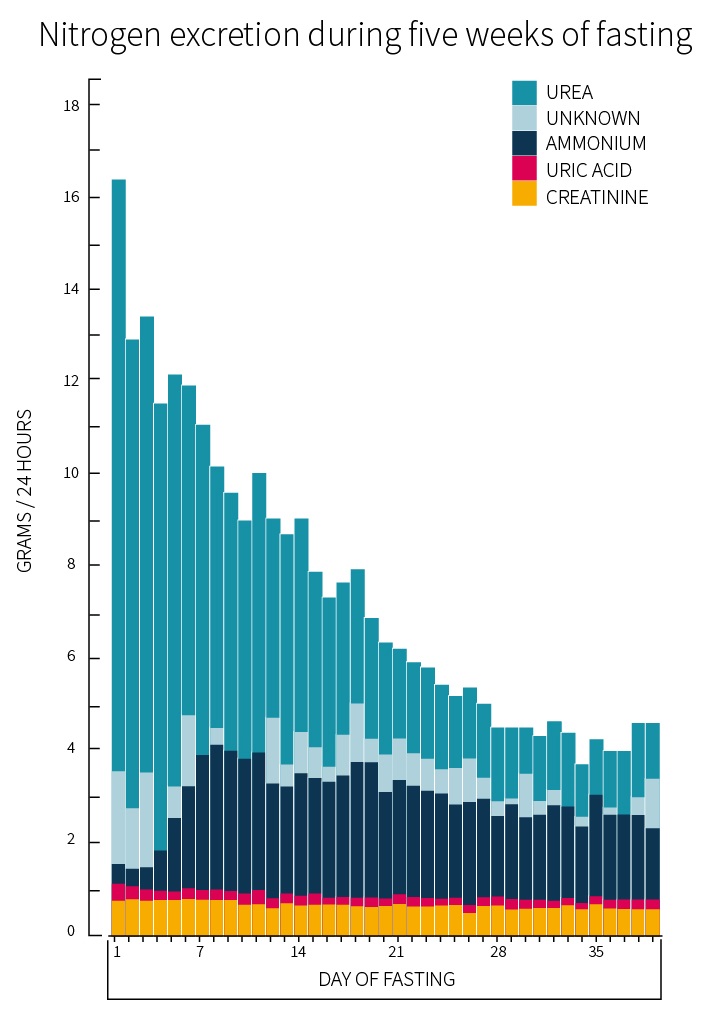Quickly and easy calculate your optimal daily intake with our protein intake calculator.
You know protein is important. You know that your protein requirements depend on your health goals, and that protein can minimize fat gains during the holidays and help with dieting in general.
But here are five interesting facts you still might not know.
1. Thermic effect of food
The thermic effect of food (TEF), also known as dietary induced thermogenesis (DIT) and specific dynamic action (SDA), represents the energy (the calories) you need to spend to process what you eat. The TEF consists of two separate components: obligatory and regulatory. The obligatory component represents the energy required to digest, absorb, and metabolize the food. The regulatory component represents the energy lost as heat.[1]
In other words, your body needs to use energy to extract energy from the food you eat. The TEF represents about 10% of the caloric intake of healthy adults eating a standard mixed diet, but your actual number will depend on several factors, which include your lean body mass and the size and composition of your meal.
The bigger your meal and the more lean mass you carry, the longer you’ll keep spending energy to process the food, which is why the TEF should be measured for at least five hours after the meal was eaten.[2] And the composition of the meal matters because the different macronutrients have different TEFs:[3]
- Fat: 0–3%
- Carbohydrates: 5–10%
- Protein: 20–30%
Although it represents but a small percentage of your daily caloric expenditure, the TEF can still amount to several hundred kilocalories each day and so could affect your body composition over the long term. Now you might think, judging from the numbers above, that increasing your protein intake should help you diet down. And well, yes, it should, but probably not because of the resulting increase in TEF — not directly, at least.
One analysis reported that, while protein was the only significant determinant of the total TEF, every 1% increase in calories from protein was associated with a mere 0.22% increase in the total TEF.[4] Based on these findings, if you were to double your protein intake from 15% to 30%, your daily TEF would increase by only 3.3%. So for each 2,000 kcal you consume (a number that might represent your total daily needs), you’d be spending an additional 66 kcal — a number easily offset by one small apple or a handful of potato chips.
Your body burns more energy digesting protein than it does either carbohydrate or fat, yet increasing your protein intake has a negligible effect on your energy expenditure.
However, while increasing your daily TEF by consuming more protein isn’t likely to have a direct effect on weight loss, as we saw, increasing the TEF of a meal might promote weight loss indirectly by increasing satiety, as we’ll see.
2. Satiety
Satiety and satiation are often used interchangeably to mean “satisfying hunger”. Technically speaking, however, satiation describes the lack of desire to continue eating a meal, whereas satiety is the feeling of fullness that allows us to stop eating for a while. In this article, when we use the adjective satiating, as in the paragraph below, we refer to satiety.
Protein is the most satiating macro,[5] especially for women,[6] which helps explain why high-protein diets promote weight loss and weight-loss maintenance.[7] But why is protein especially satiating?
Although many hormones play a role in regulating appetite,[8] three intestinal hormones have received special attention: cholecystokinin (CCK), glucagon-like peptide-1 (GLP-1), and peptide YY (PYY).[9][10] Yet none of the three seems a good predictor of the effect that eating more or less protein will have on total food intake, as evidenced by a meta‐analysis of nine studies involving a total of 117 healthy, normal-weight men.[11] Rather, other factors — such as protein’s high TEF — may explain the satiating effect of high-protein diets. In lean women, greater 24-hour TEF was shown to correlate with greater satiety.[12]
One meta-analysis of individual-participant data from five randomized meal-test studies reported no significant association between satiety and protein intake, but only 8 of the total 111 participants had received meals in which >20% of calories came from protein,[13] whereas protein seems to increase satiety only when it makes for 25–81% of a meal’s calories.[5] Therefore, the lack of an association between satiety and protein intake reported in the aforementioned meta-analysis may apply only to meals with a normal protein content (about 15% of calories).[13] In other words, the TEF of a meal increases satiety only when the meal is high in protein.
Eating protein may also promote satiety by increasing the rate of intestinal gluconeogenesis (IGNG) — the rate of glucose production within intestinal cells.[14][15] Currently, only rodent studies exist to suggest that IGNG is a key signal to the brain with regard to energy homeostasis, but important enzymes involved in gluconeogenesis have been found in the small intestine of humans, suggesting that IGNG may also take place within us.[16]
Finally, amino acids may promote satiety by directly affecting the brain.[17] Specifically, they appear to activate mTOR and suppress AMPK within hypothalamic and arcuate nucleus neurons, thus causing a decrease in the orexigenic neuropeptide Y and an increase in the anorexigenic peptide α-MSH.[18] The branched-chain amino acid (BCAA) leucine appears to be particularly satiating;[19][20] and can reduce food intake when directly injected into the brains of rodents.[21]
Protein increases satiety more than carbohydrate and fat do, by increasing thermogenesis and through the direct effect of its constituent amino acids (notably leucine) on the brain.
3. You don’t need protein, you need amino acids
All protein, including the protein you eat and the protein in your body, is synthesized from some combination of amino acids. Of the 20 amino acids that play a role in protein synthesis, only 9 are considered essential amino acids (EAAs) — amino acids your body cannot synthesize and thus must get through foods. The other 11 amino acids, which your body can synthesize, are called nonessential amino acids (NEAAs).
There are times, however, when specific NEAAs may become essential due to a disease or transient condition. Such amino acids are called conditionally essential. For example, glutamine can become essential for burn victims, whose bodies use it faster than they can synthesize it,[22] and tyrosine can become essential for people with phenylketonuria (PKU).[23]

Everyone focuses on protein requirements, but only because protein gives the body what it really needs: amino acids. In the wild, you can’t eat amino acids in isolation; but this doesn’t change the fact that EAAs are all your body truly cares about.
Furthermore, you don’t need the same amount of each EAA. The branched-chain amino acids (BCAAs) alone account for nearly half of your total EAA requirements, and you need nearly ten times more leucine than you do tryptophan.
 Based on data from the World Health Organization’s official report on protein requirements and National Academies’ Health and Medicine Division’s Dietary Reference Intakes for protein.
Based on data from the World Health Organization’s official report on protein requirements and National Academies’ Health and Medicine Division’s Dietary Reference Intakes for protein.
The need to consider EAA requirements rather than protein requirements has implications in different fields, from medical nutrition to sport nutrition. For instance, plant-based protein supplements, which tend to be poor in leucine and lysine, could be made more anabolic through fortification with those two amino acids.[24]
Or take collagen: it contains no tryptophan and so cannot, as sole protein source, sustain life.[25] Tryptophan-fortified collagen, however, has been used successfully as the sole protein source of critically ill patients,[25] and combining collagen with meat enhances the growth of rats.[26][27] This greater growth is probably due, at least in part, to collagen’s high glycine content, as glycine gets added to the diets of livestock to maximize growth (through collagen production, nitrogen retention, and skeletal-muscle development), as well as mucin production and immune function.[28]
Your body does not need protein; instead, of the 20 amino acids that make up dietary protein, your body needs to consume the 9 it cannot synthesize. You need a different amount of each of those 9 essential amino acids (EAAs), and dietary proteins are themselves made of different combinations of amino acids. You should therefore take into consideration not just your total protein intake but also your intake of specific amino acids.
4. Your body is a protein-recycling factory
Your DNA holds the blueprints to more than 25,000 protein-based compounds involved in countless essential functions. If you don’t eat protein, you die. If you don’t eat enough protein (or rather, enough of all the EAAs), you might survive but suffer from lethargy, weakness, muscle wasting, impaired healing, accelerated aging, bone loss, hair loss, heart problems, hormone imbalances, mood disorders, a weakened immune system, and so on and so forth.[29]
The total amount of amino acids available to your body for protein synthesis and other functions is called the amino-acid pool. Whenever your body uses amino acids, it gets them from this pool, which gets replenished both by the protein you eat and by your body’s own protein. Your body is constantly breaking down its old and damaged proteins, recycling any amino acids it can and rebuilding these protein structures if appropriate, in a process called protein turnover.
When you fast (which you do every night when you sleep), your body can only get the amino acids it needs through the breakdown of its own protein. About 85% of the protein your body is ready to sacrifice comes from its skeletal muscles, with nearly all the rest coming from its skin. Following an overnight fast, skin-protein breakdown and synthesis still balance each other, but muscle-protein breakdown (MPB) is about 30% greater than muscle-protein synthesis (MPS).[30] This discrepancy is due to your body using the EAAs released from your skeletal muscles to synthesize the proteins your organs need to keep you alive.[31]
But what happens when you fast for more than just the night? What if you fast for days or weeks? Early starvation studies in obese adults reported that lean body mass accounted for half of total weight loss during a 23-day fast, and that daily muscle-protein losses averaged about 32 grams per day.[32][33] Since muscle tissue is only about 20% protein by weight, the overall muscle loss was about 160 grams per day.
The rate of muscle loss, however, can increase or decrease depending on several factors, of which we’ll mention two.
- Lean people will lose a higher proportion of muscle.[34][35] The leaner you are, the more muscle a fast will cost you. This concept is referred to as the P-ratio, or ratio of protein loss relative to fat-mass loss.

- The rate of muscle loss during a fast decreases with time. Your body is smart and adaptive: it downregulates MPS and immune function so as to reduce the amount of EAAs it needs.[36] Therefore, nitrogen loss and muscle-protein loss are much, much greater during the initial days of a fast, before adaptive mechanisms kick in.[37]

The breakdown of skeletal muscles that occurs during a fast is not healthy over the long term. Muscle mass plays a major role in the prevention of many metabolic disorders, such as obesity, type-2 diabetes, and osteoporosis.[38][39] Sarcopenia, the age-related loss of muscle mass,[40] is a widespread health concern with devastating consequences on survival and quality of life.[41][42]
Conversely, if you eat more protein than you need to cover your basic metabolic requirements, your body can use the surplus to build more muscle, even in your old age.[43] Of course, you also need to stimulate your muscles to grow by using them!
Getting enough protein is crucial to properly balance periods of fasting and feeding. When fasting, needed amino acids are supplied primarily by the breakdown of your skeletal muscles. When muscle-protein breakdown exceeds synthesis over the long term, muscle loss inevitably results.
5. Protein is the only pragmatically essential macronutrient
As discussed in the previous section, you need to eat protein on a daily basis in order for your body to get all the EAAs it requires to stay healthy.
- Your body has large EAA requirements.
- Your body needs different amounts of each EAA.
- Different proteins contain different amounts of each EAA.
Those three factors combine to make it easy for you not to get enough of each EAA, even if you technically consume enough protein. Vegetarians are especially at risk, because unlike most animal-based proteins, most plant-based proteins are poor in one or more EAA.
On the other hand, your body is able to synthesize enough carbohydrates to satisfy its basic needs, even during complete starvation, making this macronutrient nonessential.
Your body does need to be fed certain fats: linoleic acid (LA) and alpha-linolenic acid (ALA) are the two fatty acids your body cannot synthesize — the two essential fatty acids (EFAs). It took 50 years of research to discover their essentiality, however, due to the difficulties in causing deficiencies in adult humans.[44] Our EFA requirements are so low, and EFAs are so abundant in our foods, that dietary fat intake needs to be close to zero for an extended period of time for a deficiency to develop. If you just fast for a couple of days, your body can extract the EFAs it needs from its fat stores. Ultimately, to cause deficiencies, clinical studies needed to feed people highly purified, zero-fat diets for two weeks.[45]
On the other hand, it is very possible to undereat protein, which is thus the only pragmatically essential macronutrient.
This concept is illustrated by the protein-sparing modified fast (PSMF), a semistarvation diet designed to promote rapid fat loss with minimal muscle loss and minimal hunger. The PSMF consists in eating adequate protein with little to no carbohydrate or fat.[46] In PSMF studies, the subjects ate very lean meats twice or thrice a day, for a total of 1.5 g of protein per kilogram of ideal body weight per day (0.68 g/lb/day),[47][48] so just 102 g of protein a day for an ideal weight of 150 lb. Salt, potassium, calcium, and a multivitamin are also taken daily to ensure adequate intake of vitamins, minerals, and electrolytes, and there is no restriction on fluid intake.
It is an effective diet protocol for the obese, with patients losing an average of 21.4 kg (47 lb) in less than 18 weeks.[49] In other words, weight loss averaged about 1.2 kg (2.7 lb) per week. Another analysis reported a loss of 12.3 kg (27 lb) after 3 months, with 84% of that weight being fat.[50] Even in obese adolescents, preliminary evidence suggests that a PSMF results in substantial weight loss without adverse events.[51]
A dietary protein deficiency is very possible even in people whose caloric intake is sufficient. The protein-sparing modified fast, in which only protein is consumed, was designed specifically to mimic starvation and promote rapid fat loss without health issues and with minimal loss of muscle mass.
Quickly and easy calculate your optimal daily intake with our protein intake calculator.
References
- ^Jequier EThermogenic responses induced by nutrients in man: their importance in energy balance regulationExperientia Suppl.(1983)
- ^Sehgal SN, Camardo JS, Scarola JA, Maida BTRapamycin (sirolimus, rapamune)Curr Opin Nephrol Hypertens.(1995 Nov)
- ^Tappy LThermic effect of food and sympathetic nervous system activity in humansReprod Nutr Dev.(1996)
- ^Westerterp KRDiet induced thermogenesisNutr Metab (Lond).(2004 Aug 18)
- ^Veldhorst M, Smeets A, Soenen S, Hochstenbach-Waelen A, Hursel R, Diepvens K, Lejeune M, Luscombe-Marsh N, Westerterp-Plantenga MProtein-induced satiety: effects and mechanisms of different proteinsPhysiol Behav.(2008 May 23)
- ^Westerterp-Plantenga MS, Lejeune MP, Smeets AJ, Luscombe-Marsh NDSex differences in energy homeostatis following a diet relatively high in protein exchanged with carbohydrate, assessed in a respiration chamber in humansPhysiol Behav.(2009 Jun 22)
- ^Soenen S, Westerterp-Plantenga MSProteins and satiety: implications for weight managementCurr Opin Clin Nutr Metab Care.(2008 Nov)
- ^Austin J, Marks DHormonal regulators of appetiteInt J Pediatr Endocrinol.(2009)
- ^D'Alessio DIntestinal hormones and regulation of satiety: the case for CCK, GLP-1, PYY, and Apo A-IVJPEN J Parenter Enteral Nutr.(2008 Sep-Oct)
- ^De Silva A, Bloom SRGut Hormones and Appetite Control: A Focus on PYY and GLP-1 as Therapeutic Targets in ObesityGut Liver.(2012 Jan)
- ^Schober G, Lange K, Steinert RE, Hutchison AT, Luscombe-Marsh ND, Landrock MF, Horowitz M, Seimon RV, Feinle-Bisset CContributions of upper gut hormones and motility to the energy intake-suppressant effects of intraduodenal nutrients in healthy, lean men - a pooled-data analysisPhysiol Rep.(2016 Sep)
- ^Westerterp-Plantenga MS, Rolland V, Wilson SA, Westerterp KRSatiety related to 24 h diet-induced thermogenesis during high protein/carbohydrate vs high fat diets measured in a respiration chamberEur J Clin Nutr.(1999 Jun)
- ^Ravn AM, Gregersen NT, Christensen R, Rasmussen LG, Hels O, Belza A, Raben A, Larsen TM, Toubro S, Astrup AThermic effect of a meal and appetite in adults: an individual participant data meta-analysis of meal-test trialsFood Nutr Res.(2013 Dec 23)
- ^Mithieux GA novel function of intestinal gluconeogenesis: central signaling in glucose and energy homeostasisNutrition.(2009 Sep)
- ^Mithieux G, Andreelli F, Magnan CIntestinal gluconeogenesis: key signal of central control of energy and glucose homeostasisCurr Opin Clin Nutr Metab Care.(2009 Jul)
- ^Yánez AJ, Nualart F, Droppelmann C, Bertinat R, Brito M, Concha II, Slebe JCBroad expression of fructose-1,6-bisphosphatase and phosphoenolpyruvate carboxykinase provide evidence for gluconeogenesis in human tissues other than liver and kidneyJ Cell Physiol.(2003 Nov)
- ^Tome DProtein, amino acids and the control of food intakeBr J Nutr.(2004 Aug)
- ^Tomé D, Schwarz J, Darcel N, Fromentin GProtein, amino acids, vagus nerve signaling, and the brainAm J Clin Nutr.(2009 Sep)
- ^Journel M, Chaumontet C, Darcel N, Fromentin G, Tomé DBrain responses to high-protein dietsAdv Nutr.(2012 May 1)
- ^Morrison CD, Laeger TProtein-dependent regulation of feeding and metabolismTrends Endocrinol Metab.(2015 May)
- ^Cota D, Proulx K, Smith KA, Kozma SC, Thomas G, Woods SC, Seeley RJHypothalamic mTOR signaling regulates food intakeScience.(2006 May 12)
- ^Lacey JM, Wilmore DWIs glutamine a conditionally essential amino acid?Nutr Rev.(1990 Aug)
- ^Al Hafid N, Christodoulou JPhenylketonuria: a review of current and future treatmentsTransl Pediatr.(2015 Oct)
- ^van Vliet S, Burd NA, van Loon LJThe Skeletal Muscle Anabolic Response to Plant- versus Animal-Based Protein ConsumptionJ Nutr.(2015 Sep)
- ^Stuart PS, Bell SJ, Molnar JUse of tryptophan-fortified hydrolyzed collagen for nutritional supportJ Diet Suppl.(2008)
- ^Tekeev AAThe importance of collagen in the biological value of meatGig Sanit.(1997 Mar-Apr)
- ^Gorshkov AI, Tekeev AA, Kovalev IuI, Tokaev ES, Rogov IAThe relation of the biological value of meat proteins to their content of connective tissueVopr Pitan.(1990 Nov-Dec)
- ^Li P, Wu GRoles of dietary glycine, proline, and hydroxyproline in collagen synthesis and animal growthAmino Acids.(2018 Jan)
- ^Wu GDietary protein intake and human healthFood Funct.(2016 Mar)
- ^Biolo G, Gastaldelli A, Zhang XJ, Wolfe RRProtein synthesis and breakdown in skin and muscle: a leg model of amino acid kineticsAm J Physiol.(1994 Sep)
- ^Cahill GF Jr, Aoki TTStarvation and body nitrogenTrans Am Clin Climatol Assoc.(1971)
- ^Cahill GF JrFuel metabolism in starvationAnnu Rev Nutr.(2006)
- ^Owen OE, Smalley KJ, D'Alessio DA, Mozzoli MA, Dawson EKProtein, fat, and carbohydrate requirements during starvation: anaplerosis and cataplerosisAm J Clin Nutr.(1998 Jul)
- ^Dulloo AG, Jacquet J, Montani JP, Schutz YHow dieting makes the lean fatter: from a perspective of body composition autoregulation through adipostats and proteinstats awaiting discoveryObes Rev.(2015 Feb)
- ^Dulloo AG, Jacquet J, Miles-Chan JL, Schutz YPassive and active roles of fat-free mass in the control of energy intake and body composition regulationEur J Clin Nutr.(2017 Mar)
- ^Young VR, Marchini JSMechanisms and nutritional significance of metabolic responses to altered intakes of protein and amino acids, with reference to nutritional adaptation in humansAm J Clin Nutr.(1990 Feb)
- ^Owen OEKetone bodies as a fuel for the brain during starvationBiochemistry and Molecular Biology Education.(2006)
- ^McLeod M, Breen L, Hamilton DL, Philp ALive strong and prosper: the importance of skeletal muscle strength for healthy ageingBiogerontology.(2016 Jun)
- ^Wolfe RRThe underappreciated role of muscle in health and diseaseAm J Clin Nutr.(2006 Sep)
- ^Cao L, Morley JESarcopenia Is Recognized as an Independent Condition by an International Classification of Disease, Tenth Revision, Clinical Modification (ICD-10-CM) CodeJ Am Med Dir Assoc.(2016 Aug 1)
- ^Woo T, Yu S, Visvanathan RSystematic Literature Review on the Relationship Between Biomarkers of Sarcopenia and Quality of Life in Older PeopleJ Frailty Aging.(2016)
- ^Brown JC, Harhay MO, Harhay MNSarcopenia and mortality among a population-based sample of community-dwelling older adultsJ Cachexia Sarcopenia Muscle.(2016 Jun)
- ^Volpi E, Kobayashi H, Sheffield-Moore M, Mittendorfer B, Wolfe RREssential amino acids are primarily responsible for the amino acid stimulation of muscle protein anabolism in healthy elderly adultsAm J Clin Nutr.(2003 Aug)
- ^Spector AA, Kim HYDiscovery of essential fatty acidsJ Lipid Res.(2015 Jan)
- ^Wene JD, Connor WE, DenBesten LThe development of essential fatty acid deficiency in healthy men fed fat-free diets intravenously and orallyJ Clin Invest.(1975 Jul)
- ^Bistrian DR, Winterer J, Blackburn GL, Young V, Sherman MEffect of a protein-sparing diet and brief fast on nitrogen metabolism in mildly obese subjectsJ Lab Clin Med.(1977 May)
- ^Bistrian BRClinical use of a protein-sparing modified fastJAMA.(1978 Nov 17)
- ^Wadden TA, Stunkard AJ, Brownell KD, Day SCA comparison of two very-low-calorie diets: protein-sparing-modified fast versus protein-formula-liquid dietAm J Clin Nutr.(1985 Mar)
- ^Palgi A, Read JL, Greenberg I, Hoefer MA, Bistrian BR, Blackburn GLMultidisciplinary treatment of obesity with a protein-sparing modified fast: results in 668 outpatientsAm J Public Health.(1985 Oct)
- ^Zahouani A, Boulier A, Hespel JPShort- and long-term evolution of body composition in 1389 obese outpatients following a very low calorie diet (Pro'gram18 VLCD)Acta Diabetol.(2003 Oct)
- ^Bakhach M, Shah V, Harwood T, Lappe S, Bhesania N, Mansoor S, Alkhouri NThe Protein-Sparing Modified Fast Diet: An Effective and Safe Approach to Induce Rapid Weight Loss in Severely Obese AdolescentsGlob Pediatr Health.(2016 Jan 22)
